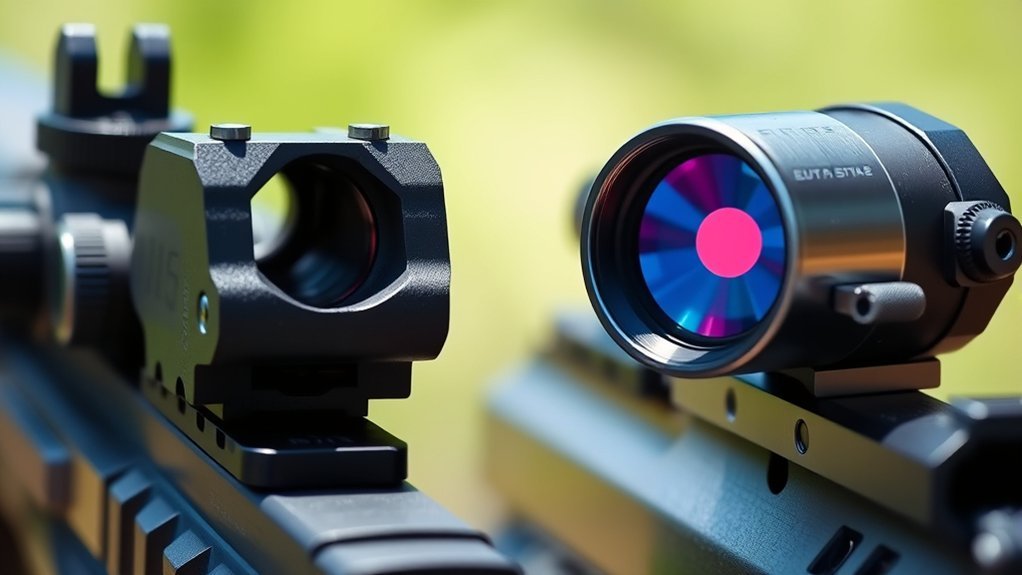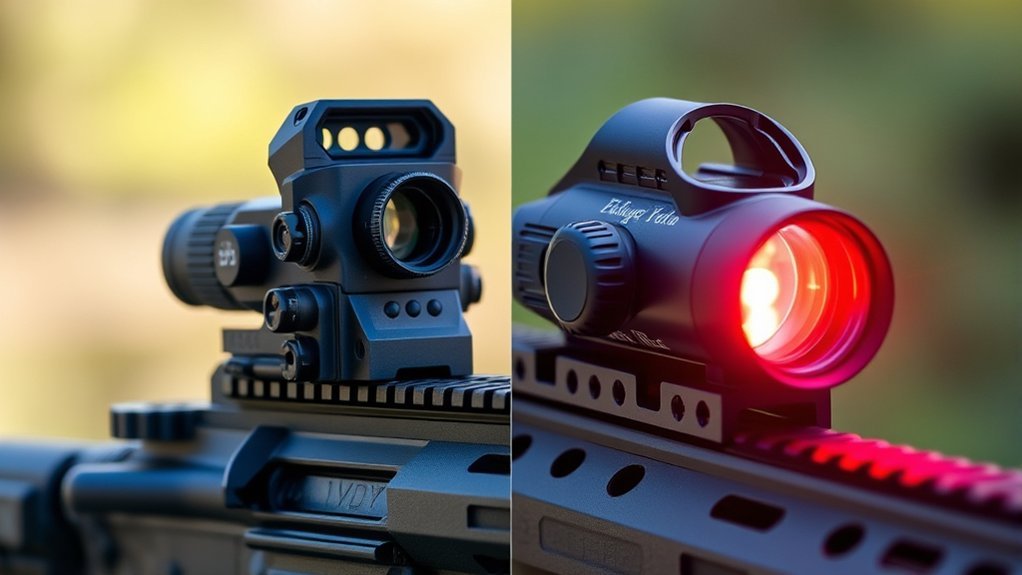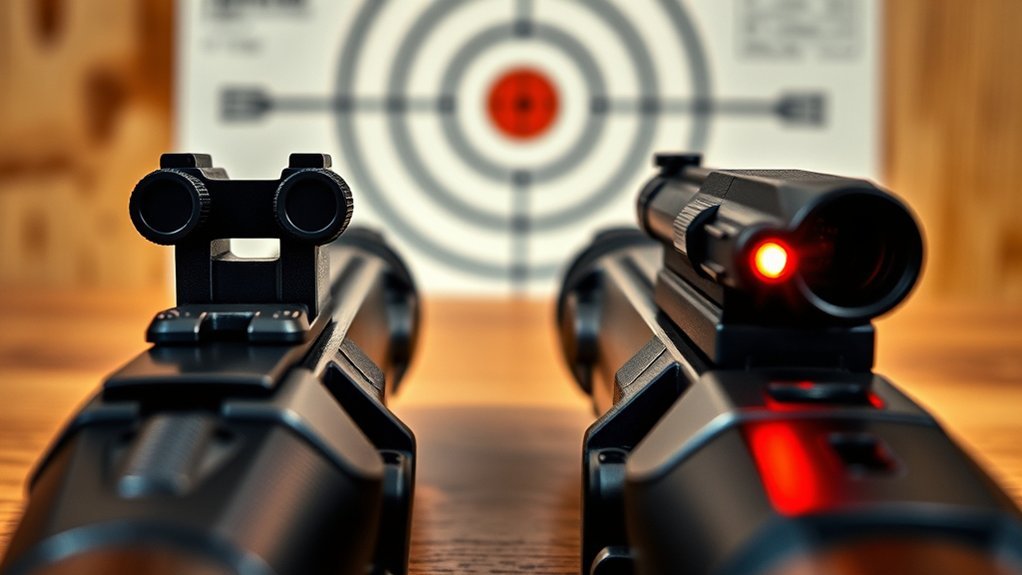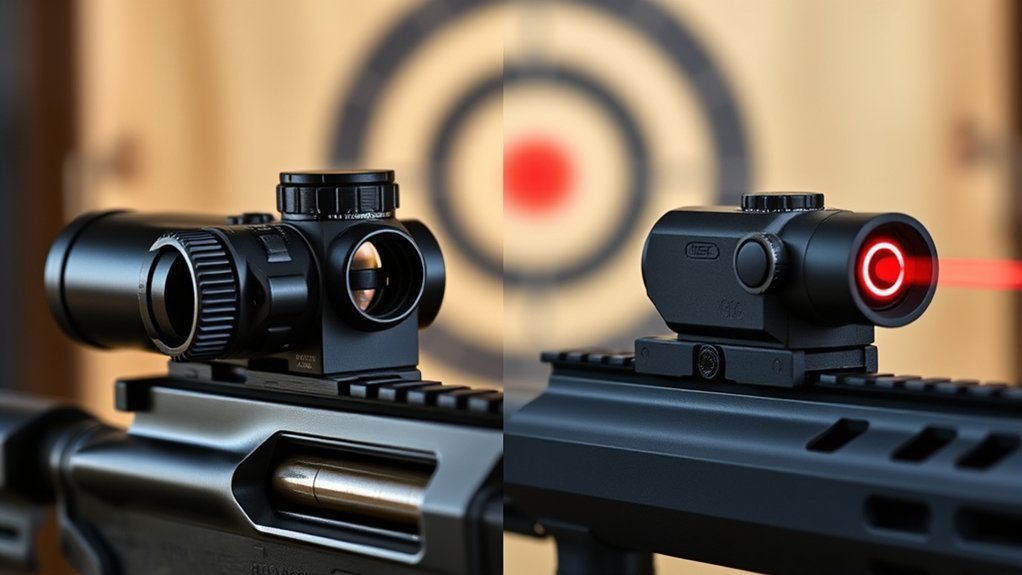Many shooters underestimate the impact of sight selection on overall performance. Iron sights and red dot sights each offer distinct advantages and challenges that can influence your shooting experience. Understanding these differences is essential for optimizing your accuracy and speed. Which sighting system aligns best with your shooting style and conditions? Let’s explore the nuances that set them apart and help you make an informed choice.
Overview of Iron Sights

Iron sights are the traditional aiming devices found on firearms, consisting of a front sight post and a rear sight aperture or notch. These sights allow you to align your eye, the front sight, and the target for accurate shooting. When using iron sights, you need to focus on the front sight while keeping the target slightly blurred, enabling faster target acquisition. Proper sight alignment and sight picture are essential for hitting your mark. You’ll often find iron sights durable and reliable, as they don’t require batteries and can withstand harsh conditions. However, they may be less effective in low-light scenarios. Mastering iron sights will enhance your shooting fundamentals and improve your overall marksmanship skills.
Overview of Red Dot Sights

While traditional iron sights require precise alignment, red dot sights offer a more intuitive aiming solution for shooters. These sights project a red dot onto a lens, allowing you to focus on your target without needing to line up front and rear sights. Red dot sights enhance situational awareness, as you can keep both eyes open, aiding in peripheral vision. They’re lightweight, easy to mount, and versatile for various firearms, including rifles and handguns. Additionally, many models feature adjustable brightness settings for different lighting conditions. Battery life varies, but quality sights often offer extended use, making them reliable for both tactical and competitive scenarios. Overall, red dot sights simplify target acquisition, improving your shooting experience.
Accuracy and Precision

Accuracy and precision are critical factors when comparing iron sights and red dot sights. Understanding how each sight system affects your shooting can help you make informed choices. Here’s what you need to evaluate:
- Iron Sights: They require alignment of front and rear sights, which can lead to slight variances in aiming, impacting precision.
- Red Dot Sights: They allow for faster target acquisition and can maintain accuracy at various distances due to the parallax-free design, enhancing precision.
- Environmental Factors: Lighting and distance can influence both sight types, but red dots often perform better in low-light conditions, improving your overall accuracy.
Choosing the right sight depends on your specific shooting needs and conditions, so weigh these factors carefully.
Speed of Target Acquisition
When it comes to speed of target acquisition, red dot sights have a distinct advantage over traditional iron sights. Red dots allow you to keep both eyes open, enhancing peripheral vision and situational awareness. This feature enables you to quickly locate targets without the need to align front and rear sights, which can slow you down. The illuminated reticle of a red dot sight offers instant visibility in various lighting conditions, allowing for faster engagement. In contrast, iron sights require precise alignment, which can be time-consuming, especially under stress. With practice, you’ll find that red dots facilitate quicker tracking and target shifts, making them ideal for dynamic shooting environments. Ultimately, they streamline the aiming process, enhancing your overall efficiency in target acquisition.
Sight Picture and Field of View
Red dot sights greatly enhance your sight picture and field of view compared to traditional iron sights. With a red dot, you can maintain situational awareness while aiming, making it easier to engage multiple targets quickly. Here are three key advantages:
- Wider Field of View: Red dots allow you to see more of your surroundings, essential for tactical situations.
- Unobstructed Sight Picture: The dot overlays your target without the need to align front and rear sights, reducing distractions.
- Parallax-Free Design: You can keep both eyes open, which helps you track moving targets and enhances depth perception.
These features make red dot sights an excellent choice for both beginners and experienced shooters, improving your overall shooting experience.
Durability and Reliability
When considering durability and reliability, the build material quality of your sights plays an essential role. Iron sights typically offer ruggedness due to their solid construction, while red dots may vary based on their housing materials. Additionally, weather resistance features can greatly impact performance, especially in harsh conditions, so it’s vital to evaluate these aspects before making a choice.
Build Material Quality
While both iron sights and red dots serve the essential purpose of enhancing target acquisition, their build material quality greatly impacts their durability and reliability. Iron sights typically use steel or aluminum, providing substantial sturdiness in rugged conditions. In contrast, red dots often utilize polymer or aluminum, which can vary in strength depending on the manufacturer.
Here are three critical factors to evaluate regarding build material quality:
- Material Composition: Steel offers greater resilience against impacts, whereas polymer can be lighter but may sacrifice durability.
- Construction Techniques: Machined components tend to be stronger than molded parts.
- Finish and Coating: Anodized or coated surfaces enhance scratch resistance and overall longevity.
Choosing the right build material is crucial for performance and longevity in the field.
Weather Resistance Features
Build material quality doesn’t only influence durability; it also plays a significant role in how well iron sights and red dots perform in various weather conditions. Iron sights, typically made from steel or aluminum, offer inherent weather resistance due to their robust construction. They can withstand rain, snow, and extreme temperatures without degradation.
On the other hand, red dot sights often feature sealed housings, often constructed from aircraft-grade aluminum or polymer, providing excellent protection against moisture and dust. Many models are also fog-proof and shock-resistant, ensuring reliable performance in adverse conditions.
Ultimately, while both options can endure harsh environments, red dots often come equipped with advanced weatherproofing technologies, giving them an edge in reliability during unpredictable conditions.
Lighting Conditions and Visibility
Effective shooting requires an understanding of how lighting conditions impact visibility, especially when comparing iron sights and red dot sights. Each system reacts differently to varying light environments, affecting your accuracy and target acquisition.
- Bright Conditions: Red dots often excel due to their illuminated reticles, which stand out against bright backgrounds, enhancing visibility.
- Low Light: Iron sights can become difficult to see without adequate light, while many red dot sights offer adjustable brightness settings for ideal visibility in darkness.
- Glare and Reflection: Iron sights may suffer from glare, while red dots can minimize this with anti-reflective coatings, ensuring clearer sight pictures.
Choosing between these options depends on the specific lighting scenarios you expect to encounter during your shooting activities.
Cost Considerations
When considering cost, the initial purchase price of iron sights and red dots can markedly differ. While iron sights are generally more affordable upfront, red dots often require additional investment in batteries and potential repairs. Evaluating long-term maintenance costs will help you determine which option offers better value over time.
Initial Purchase Price
The initial purchase price of iron sights and red dot sights can vary greatly, impacting your budget and decision-making process. Iron sights typically offer a lower upfront cost, making them an economical choice. In contrast, red dot sights often come with a higher price tag due to advanced technology. Here are three key factors to take into account:
- Quality: Higher quality materials and construction can increase costs for both options.
- Brand Reputation: Established brands may command premium prices for reliability and performance.
- Features: Additional features, like brightness settings on red dots, can greatly affect pricing.
Ultimately, understanding these factors helps you make an informed choice that aligns with your shooting needs and financial situation.
Long-term Maintenance Costs
While both iron sights and red dot sights offer distinct advantages, their long-term maintenance costs can considerably influence your overall investment. Iron sights typically require minimal upkeep. You might only need to check for alignment and verify no rust or damage occurs, which is relatively inexpensive. Conversely, red dot sights can incur higher costs over time. Battery replacements are necessary, and the need for occasional recalibration can add to your expenses. Additionally, if your red dot sight gets damaged, repairs or replacements can be costly. When considering longevity, weigh the durability of each option and factor in potential repair costs. Ultimately, your choice should align with your shooting habits and budget for upkeep.
Weight and Bulkiness
Although you might prioritize accuracy and target acquisition speed, the weight and bulkiness of your sighting system can greatly affect your overall shooting experience. A heavier sight can lead to fatigue during extended use, while bulkiness may hinder your ability to maneuver in tight spaces. Here are three key considerations regarding weight and bulkiness:
- Iron Sights: Typically lightweight, they add minimal bulk to your firearm, making them ideal for quick handling.
- Red Dots: While generally lightweight, they can be bulkier than iron sights, especially with added features like magnification.
- Balance: The weight distribution of your sighting system can influence your firearm’s handling and stability, affecting your aim and shooting comfort.
Consider these factors carefully to guarantee peak performance.
Personal Preference and Shooting Style
When choosing between iron sights and red dots, your vision and target acquisition speed play essential roles. Each option can influence your shooting discipline and may be better suited for specific environments. Understanding how these factors align with your personal preferences will enhance your overall shooting experience.
Vision and Target Acquisition
Understanding the nuances of vision and target acquisition can greatly enhance your shooting performance, whether you prefer iron sights or red dots. Each option impacts how quickly and accurately you can align your sight with your target.
Consider these factors:
- Field of View: Red dots offer a wider field of view, allowing quicker target shifts.
- Focus: Iron sights require you to focus on both the front sight and the target, while red dots let you keep your focus on the target, simplifying alignment.
- Light Conditions: Red dots perform well in low light, whereas iron sights may become harder to see without adequate lighting.
Choose the system that aligns with your vision preferences and shooting style for peak performance.
Shooting Discipline Impact
Your choice between iron sights and red dots often reflects your shooting discipline and personal style. Iron sights offer precision and reliability, appealing to traditionalists and those who favor marksmanship fundamentals. In contrast, red dots enhance speed and target acquisition, ideal for dynamic shooting scenarios.
| Feature | Iron Sights | Red Dots |
|---|---|---|
| Accuracy | High with practice | Quick, but requires zeroing |
| Speed of Targeting | Slower, needs alignment | Fast, both eyes open |
| Preference | Classic, disciplined shooters | Tactical, competitive shooters |
Ultimately, your preference can greatly impact your performance. Consider your shooting discipline and how each option aligns with your style for best results.
Environmental Considerations
While both iron sights and red dots have their advantages, environmental factors can greatly influence your choice between them. Consider the following aspects that might sway your decision:
- Lighting Conditions: In bright sunlight, red dots can wash out, making iron sights a more reliable option. Conversely, in low light, red dots can provide better visibility.
- Weather Conditions: Rain or fog can obstruct your view. Iron sights remain effective since they don’t rely on electronics, while red dots may require maintenance to function properly.
- Distance and Target Size: At long ranges or small targets, red dots offer quicker acquisition and precision. However, for closer encounters, iron sights can still perform admirably.
Ultimately, your personal shooting style and preferences will guide your decision in varying environments.
Conclusion
In choosing between iron sights and red dot sights, it’s essential to evaluate your shooting needs and environment. For instance, a competitive shooter might prefer a red dot for its rapid target acquisition during fast-paced drills, while a hunter in bright daylight may find iron sights more reliable. Ultimately, understanding the strengths and weaknesses of each sight type helps you make an informed decision that enhances your shooting experience and effectiveness in the field.

